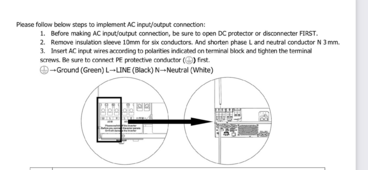I have an eg4 3000 inverter on a hand truck with one 48v battery I’m using temporarily while building a stepvan. Awhile ago while using a power tool I got a shock, so a member told me to ground the case of inverter to the chassis, which I did.
Today when testing the 120v output plug of the inverter when it’s inverting (not passing thru) I get 80v from neutral to ground, and 46v from hot to ground. From what I understand reading other threads the inverter is not bonding internally to ground like it should.
Is the wire from the case to the chassis enough, or do I need to do a jumper wire also? Like do the jumper wire trick at the shore power input maybe? I was eventually going to install a shore power cord.
Edit:
I forgot, I’m also getting some strange surging happening on a fan installed. And the controller for the fan doesn’t work well like it did when plugged into the grid.
Today when testing the 120v output plug of the inverter when it’s inverting (not passing thru) I get 80v from neutral to ground, and 46v from hot to ground. From what I understand reading other threads the inverter is not bonding internally to ground like it should.
Is the wire from the case to the chassis enough, or do I need to do a jumper wire also? Like do the jumper wire trick at the shore power input maybe? I was eventually going to install a shore power cord.
Edit:
I forgot, I’m also getting some strange surging happening on a fan installed. And the controller for the fan doesn’t work well like it did when plugged into the grid.
Last edited:




